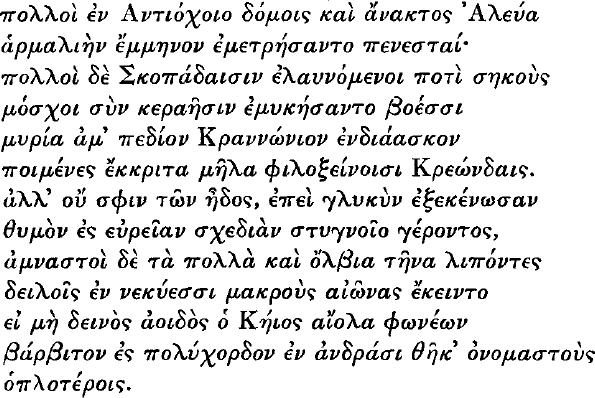No CrossRef data available.
Published online by Cambridge University Press: 23 December 2013
From the tenth Pythian ode of Pindar we learn that both the Aleuadae, who had their seat of power at Larissa, and the Skopadae, lords of Crannon, once called Ephyra, were descendants of Heracles. These families are chiefly known to us through the poets, and in the case of the Skopadae, from the passage in the Protagoras of Plato in which a poem of Simonides is discussed. The statement of Theocritus, that the great families of Thessaly would be buried in obscurity but for the songs written in their honour, is amply justified:

The Aleuadae are more conspicuous and more often mentioned than the Skopadae, who were the younger branch of the Aleuad family, as the Kreondae are the younger branch of the Skopadae at Krannon. Both families appear to have immigrated from Thesprotia. The eponym of the Aleuadae is one of the Thessalian heroes whose story brings them into connexion with the serpent, of whom the most famous is Asklepios. Of him Rohde writes: ‘In Wahrheit ist ursprünglich auch er ein in der Erde hausender thessalischer Ortsdaimon gewesen, der aus der Tiefe, wie viele solche Erdgeister, Heilung von Krankheiten, Kentniss der Zukunft (beides in alter Zeit eng verbunden) heraufsandte.’
1 Boeckh, on Pindar, , Pyth., 10, pp. 531–534Google Scholar.
2 Id., 16, 34 ff.
3 Psyche, 1, 141.
4 C.Q., xiii., 3–4, 170–171.
5 B.C.H., xvi., 573.
6 P.W., 8, 738, gives the references.
7 P.W., 8, 763.
8 Calleim, , Frag., 117Google Scholar.
9 Il., 16, 180 ff.
10 Il., 14, 490.
11 Theophrastus, , H.P., 4, 11Google Scholar.
12 Thuc., V., 71.
13 Od., 7, 136–138.
14 Handbuch, 5, 2, 1323.
15 Ditt., , Sylloge, 845, 11Google Scholar; 923, 3.
16 Aetolia, Geography, Topography, and Antiquities, Woodhouse, , p. 235Google Scholar.
17 Ditt., , Sylloge, 839, 5Google Scholar.